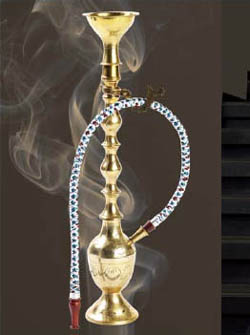AN EMERGING DEADLY TREND: HOOKAH! |
|
What’s HOOKAH? Provided by Ross Porter, Communications Director, American Lung Association of San Diego California In the last few years, new popularity for an old form of tobacco use has been gaining ground within the already-susceptible 18-to-24 age group. Waterpipes (also known Like many tobacco products, use of these pipes is linked to lung cancer and other respiratory and heart diseases. Waterpipe tobacco smokers are exposed to cancer-causing chemicals and hazardous gases such as carbon monoxide. Waterpipe users are also exposed to nicotine, the substance in tobacco that causes addictive behavior. Despite knowing the dangers of waterpipe smoking, one study found that most (more than 90%) beginning waterpipe smokers believe cigarette smoking is more addictive than waterpipe smoking. The same study also found evidencethat the use of waterpipes is increasing throughout the world. In the late 20th century, sweeter additives and more flavors were developed in Egypt in an effort to attract female consumers. As people immigrated to Europe from India, Pakistan, Northern Africa and the Middle East, hookahs and hookah cafes began appearing in European cities. Today, hookah bars and cafes are popular in many parts of Britain, France, Spain, Russia, India, Asia and throughout the Middle East and are growing in popularity in the United States. STATE of SCIENCE Although limited research has been done on the health risks of waterpipe use, the existing evidence indicates that waterpipe smoking carries the same or similar health risks as cigarette smoking. Links have been made to many of the same adverse health effects, including lung, oral and bladder cancer, as well as clogged arteries and heart disease.An analysis of mainstream smoke from waterpipes found that it contains significant amounts of nicotine, tar and heavy metals. A study of nicotine and cotinine (a chemical marker of nicotine exposure) levels in hookah smokers found high amounts of both chemicals after one session of hookah use.Nicotine and cotinine levels were measured in the participants blood before and after smoking. The level of nicotine increased up to 250 percent and the cotinine level increased up to 120 percent after just one session of smoking, lasting 40 to 45 minutes. Waterpipe use may increase exposure to carcinogens because smokers use a waterpipe over a much longer period of time, often 40 to 45 minutes, rather than the 5 to 10 minutes it takes to smoke a cigarette. Due to the longer, more sustained period of inhalation and exposure, a waterpipe smoker may inhale as much smoke as consuming 100 or more cigarettes during a single session. These studies provide compelling initial data which suggest that waterpipe smoke is at least as toxic as cigarette smoke. Existing research into the direct and singular effects of waterpipe smoking is complicated by the fact that many waterpipe users also smoke cigarettes. Another potential problem is that commonly used heat sources that are applied to burn the tobacco, such as wood cinders or charcoal, are likely to increase the health risks from waterpipe use because when burned on their own these heat sources release high levels of potentially dangerous chemicals, including carbon monoxide and metals. Finally, the social aspect of waterpipe smoking may put many users at risk for other infectious diseases, such as tuberculosis and viruses such as hepatitis and herpes. Shared mouthpieces and the heated, moist smoke may enhance the opportunity for such diseases to spread. Also, although limited research has been done in this area, the secondhand smoke from a waterpipe is potentially dangerous because it contains smoke from the tobacco itself as well as the smoke from the heat source used to burn the tobacco. More investigation is certainly needed to determine the health effects of both long- and shortterm waterpipe use, as well as the relative risk of waterpipe use compared to other forms of tobacco use. However, the available research strongly indicates that waterpipe smoking presents many of the same risks as cigarette smoking and is not a safe alternative to smoking cigarettes. Despite the evidence that waterpipe smoking has health risks at least similar to cigarette smoking, the general perception is exactly the opposite. Waterpipe tobacco smokers generally believe that it is less harmful than cigarette smoking, since most smokers believe that the water-filtration and extended hose serve as filters for harmful agents. A Growing Trend Hookah bars or cafs have sprung up in urban areas and cities and towns near large colleges or universities. Even a few of the states with strong smokefree air laws have been unable to slow the emergence of hookah bars and cafs. California, Illinois, New York, Texas and Virginia currently have the greatest number of these establishments, most of them located in major cities or near universities. However, hookah bars and cafs have appeared in more than two-thirds of the states. Based on U.S. business listings and categorized web-listings, an estimated 200 to 300 of them currently operate in the United States, with more appearing every day. In California, some hookah lounges have been able to bypass the state smokefree air law by making employees co-owners, thereby qualifying for exemption as an establishment with no employees. While California state law prohibits smoking in most workplaces, it is allowed in retail or wholesale tobacco shops and private smoking lounges. Local communities have begun to pass ordinances to address and eliminate these loopholes. Conclusion Waterpipes can become yet another inducement to smoking that appeal particularly to a younger audience attracted by the reportedly sweeter, smoother smoke. New smokefree air laws should include hookahs and the places where hookahs are smoked and remove loopholes from existing laws that make hookahs popular and accessible. Health care providers, quitlines and university administrators should also consider offering culturally appropriate cessation products and services to help waterpipe smokers attempt to quit. The American Lung Association is publishing a 10-page brief about the health effects of Hookah use, in recognition of this growing national trend. “Hookah tobacco use is not a safe alternative to cigarettes,” said John L. Kirkwood, President and CEO of the American Lung Association. For a pdf download of the report, click here: Trendalert_Waterpipes. In San Diego, Hookah use continues to be a growing trend that needs regulation. The public – especially youth who are targets of this growing industry - should know more about the health hazards of Hookah use. The American Lung Association will celebrate 100 years of working for lung health in San Diego County at the 2007 event, Evening in the Sky. At work on cures, clean air, and smoke-free kids, the American Lung Association holds its annual Asthma Walk in September. Learn more at www.LungSanDiego.org or call 800-LUNG-USA. |
![]()
TEL- 619-427-4111 Email - Health@infooption.com
Salud+HealthInfo is for information and educational purposes only. You should not rely on this information as a substitute for personal medical attention, diagnosis or hands-on treatment. If you are concerned abut your health or that of a child, please consult your family's physician or health provider immediately and do not try to diagnose yourself.
Copyright © 2001-2006 Info Option Network
 info
info

 as hookahs) are the first new tobacco trend of the 21st century. Originating in the Middle East and spreading throughout Europe and the United States, these small, inexpensive, and socially-used tobacco pipes have become as fashionable as cigars were in the later 1990s, especially among urban youth, young professionals, and college students. Small cafs and clubs that rent the use of hookahs and sell special hookah tobacco are making their mark on the young, hip, urban scene.
as hookahs) are the first new tobacco trend of the 21st century. Originating in the Middle East and spreading throughout Europe and the United States, these small, inexpensive, and socially-used tobacco pipes have become as fashionable as cigars were in the later 1990s, especially among urban youth, young professionals, and college students. Small cafs and clubs that rent the use of hookahs and sell special hookah tobacco are making their mark on the young, hip, urban scene.